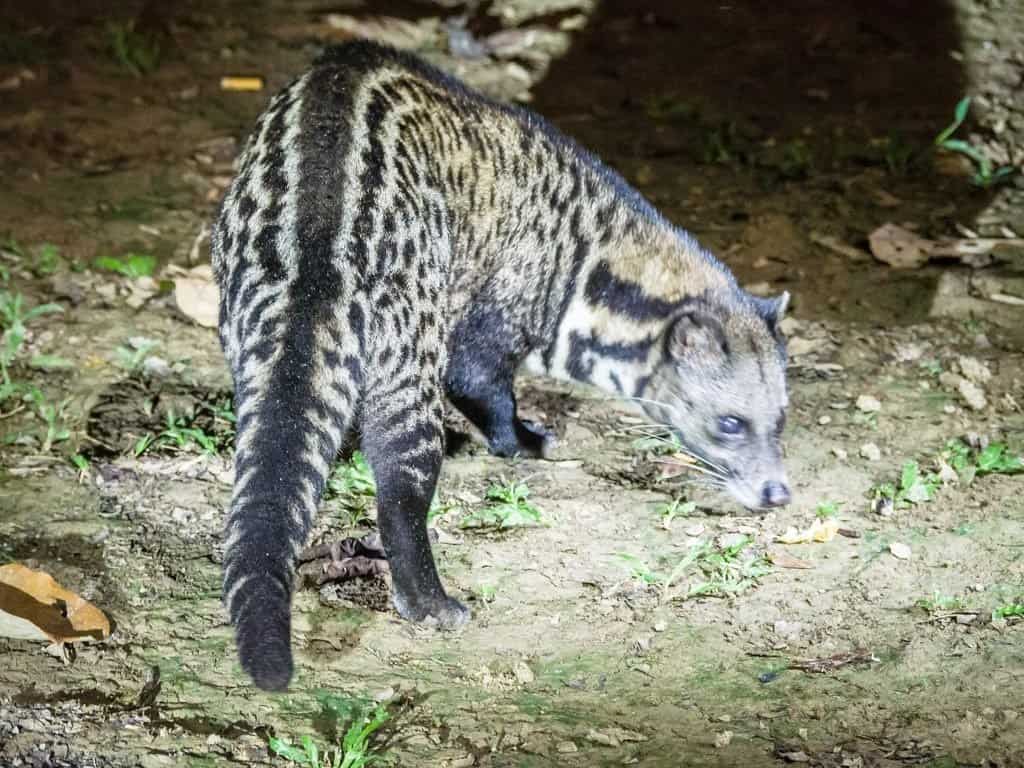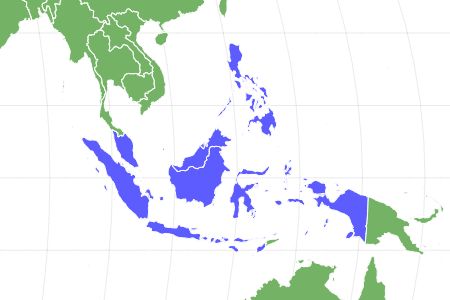Malayan Civet
Viverra tangalunga
Also known as the Oriental Civet!
Advertisement
Malayan Civet Scientific Classification
- Kingdom
- Animalia
- Phylum
- Chordata
- Class
- Mammalia
- Order
- Carnivora
- Family
- Viverridae
- Genus
- Viverra
- Scientific Name
- Viverra tangalunga
Read our Complete Guide to Classification of Animals.
Malayan Civet Conservation Status
Malayan Civet Facts
- Main Prey
- Rodents, Snakes, Frogs
- Distinctive Feature
- Elongated body and snout with sharp, pointed teeth
- Habitat
- Tropical rainforest
- Predators
- Tiger, Snakes, Leopards
- Diet
- Carnivore
- Average Litter Size
- 2
- Lifestyle
- Solitary
- Favorite Food
- Rodents
- Type
- Mammal
- Slogan
- Also known as the Oriental Civet!
View all of the Malayan Civet images!
“The Mayalan Civet is the most distinguishable civet due to its dark legs and its long, striped tail”
The species of civet is common in Southeast Asia, but is native to the Malay Peninsula. Also known as the Malay Civet and Oriental Civet, it inhabits the rainforests and tropical jungles in mainland Malaysia, the Phillippines, Indonesia, and Singapore. It is valued for food and musk but treated as a pest when dwelling near people.
Incredible Malayan Civet Facts!
- It is one of the species that can be tamed and kept to extract musk.
- This species was introduced to the Maluku islands surrounding the Malay Peninsula.
- It is ground-dwelling, but will climb trees if necessary.
- It has adapted to deforestation to include other habitats.
- The 15 black bands on its tail give it more camouflage.
Malayan Civet Scientific name
The Malayan Civet’s scientific name is Viverra tangalunga. Tangalunga refers to the species. Viverra is the genus of civets. It is a genus of the family Viverridae which consists of small to medium-sized mammals known as viverrids (civets and genets) and contains 15 genera, which are subdivided into 38 species.
Common to all viverrids are feet with four or five toes and retractable claws. Each jaw has six incisors and molars in front of two tubercular grinders in the upper jaw, with one grinder in the lower jaw. The tongue is rough and prickly. There is no cecum. There are two subspecies of Mayalan Civet: Viverra tangalunga lankavensis and Viverra tangalunga tangalunga.
Civets fall into the Feliformia (also known as Feloidea) suborder of the order Carnivora, as do cats, hyenas, mongooses and other cat-like carnivorans. They are actually not related to cats but are closely related to other small carnivores such as weasels and mongooses. However, they are more primitive and have less diversity than Felidae (cats).
Malayan Civet Appearance
Like other civets, this species shares the whiskers, long, slender and sleek body, feet, teeth and other physical features. Its fur resembles the coloring and pattern of a cheetah. Its long tail has a vertical black stripe on top with bands underneath against pale fur. The rest of its fur has black spots.
It has a somewhat pointed snout and its fur is the color black plus either brown, grey, yellow, tan, or white. The feet are all black. Malayan Civets have an average weight of 3.5-11kg (7.72-24.25lb) a body length of 58.5-95cm (23-37.4in), and a tail length of 30-48.2cm (11.8-19in). Females have two or three pairs of teats, while males have a baculum.

©Mike Prince from Bangalore, India / CC BY 2.0 – License
Malayan Civet Behavior
Malayan Civets are solitary, territorial creatures. They come out at night to hunt for food on the forest floor. They also climb trees to hunt for food or to hide from predators. During the day, they are sedentary and sleep under the cover of trees. They hunt by stalking and pouncing on their prey. When threatened or communicating with other civets by scent, they secrete a musk called civet or civetone from their perianal glands. They are not aggressive unless cornered.
Malayan Civet Habitat
The Malayan Civet’s native habits are originally the rainforests and tropical jungles of the Malay Peninsula and the surrounding islands of the Riau Archipelago, Borneo, Banggi, Langkawi, and Penang. It also lives in Sumatra, Sulawesi, the Indonesian islands of Java, Bawal and Telok Pai, and the Phillippine island of Leyte.
It range of habits has expanded beyond primary forests to include the disturbed land of secondary forests along with brush, grasslands and mountain forests. They also live near villages in order to steal poultry, but never far from trees. The mean range overlap of territories among civets are 15% for males and 0% for females, while the home range of each male overlaps one or two females. The species enjoys high altitudes and have had habitats up to 1100m high.
Malayan Civet Diet
The favorite prey of the Malayan Civet is mice, rats and other rodents. Eggs, Lizards, snakes, frogs, insects and other small creatures from the forest floor also make up the bulk of its diet. However, they include fruit and some roots, so while they rely on the protein from small vertebrates and invertebrates, they are actually omnivorous. For example, they enjoy the seed pods of the Rain Tree, the fruits of the Fishtail Palm, mangoes, bananas and sapota.
Malayan Civet Predators and threats
Malayan Civets may compete with palm civets in logged forests over food. Timber harvesting in Borneo for palm oil plantations threaten their habitats there. The species is a predatory animal but has many predators that are larger carnivores, including large cats such as tigers and leopards and large reptiles such as large snakes and crocodiles.
It also runs the risk of being snared or experiencing other forms of ground-level trapping along with being hunted by dogs. However, the species persists and adapts in spite of general levels of threat. People treat it as a pest that raids fruit, poultry, and other small livestock, and occasionally hunt it for food.
Malayan Civet Reproduction, Babies, and Lifespan
Males and females come together for mating and the females raise the young. Females reproduce twice a year and give birth in dense vegetation, hollow tree trunks or holes in the ground. Gestation lasts a couple of months. Litters have up to 4 kittens but 2 on average. Sometimes, the mothers eat their young right after giving birth. The kittens are born with fur and eyes closed and are weaned after a month. They can crawl at birth and their hind legs can support them after about 5 days. They start venturing out on their own two or three months after birth.
Malayan Civets on average live 5-12 years and even up to 20 years. Such an age is rare, so it is more common to see older civets live between 15 to 20 years instead.
Malayan Civet Population
The density of Malayan Civet populations are denser in unlogged forests as opposed to logged. The species’ secretiveness makes it difficult to determine their population, but their numbers remain stable. Their conservation status is “vulnerable” and currently “not threatened,” while the IUCN red list states it is of “least concern.” They are treated as a pest in rural areas of the Malay Peninsula. Under Section 55 of the WPA of 1972, farmers can shoot any threatening wild animal after making a reasonable effort to frighten it away.
Malayan Civet In the Zoo
The Malayan Civet lives about 12 years in captivity. It is often housed with other viverrid species, such as other civets or genets. Their enclosures are large, filled with shrubbery, tall grasses, artificial caves, and many other different types of high spots and hiding places. When rescued young, they require round-the-clock care. This species is one of the attractions at zoos not only in Southeast Asian countries but in Europe, including Hungary, France, and the UK.
View all 164 animals that start with MMalayan Civet FAQs (Frequently Asked Questions)
What is a Malayan civet?
Also called the Oriental Civet or Malaysian Civet, it is a species of civet native to the rainforests and tropical jungles of Malaysia and the surrounding islands.
What is the scientific name for Malayan civet?
Viverra tangalunga
Is a civet a rodent?
No, civets are not rodents. Rodents make up a large part of civets’ diets. Both civets and rodents are in the class Mammalia, but that’s where their similarities end.
Is a civet a cat?
Civets are also called civet cats due to their general similarities in appearance to cats as well as the strong odor they secrete. They are actually more closely related to mongooses. However, civets, mongooses, and cats all fall into the Feliformia suborder of the order Carnivora. Feliformia is a broad group that means “cat-like.”
What family is a civet in?
Civets are in the family Viverridae, also called viverrids.
What is the Malayan Civet valued for?
The Malayan Civet is valued as a food source and especially in the economy as live trade animals for its musk. This musk has medicinal purposes and its strong scent makes it a base for perfumes. Although other species of civet are killed for their musk, the Malayan Civet can be tamed and kept for extraction. Sometimes, it is kept as a pet but as a wild animal requires a license.
Are Malayan Civets herbivores, carnivores, or omnivores?
Malayan Civets are Carnivores, meaning they eat other animals.
What Kingdom do Malayan Civets belong to?
Malayan Civets belong to the Kingdom Animalia.
What is the lifespan of a Malayan Civet?
Malayan Civets can live for 15 to 20 years.
Thank you for reading! Have some feedback for us? Contact the AZ Animals editorial team.
Sources
- David Burnie, Dorling Kindersley (2011) Animal, The Definitive Visual Guide To The World's Wildlife
- Tom Jackson, Lorenz Books (2007) The World Encyclopedia Of Animals
- David Burnie, Kingfisher (2011) The Kingfisher Animal Encyclopedia
- Richard Mackay, University of California Press (2009) The Atlas Of Endangered Species
- David Burnie, Dorling Kindersley (2008) Illustrated Encyclopedia Of Animals
- Dorling Kindersley (2006) Dorling Kindersley Encyclopedia Of Animals
- David W. Macdonald, Oxford University Press (2010) The Encyclopedia Of Mammals
- Wikipedia, Available here: https://en.wikipedia.org/wiki/Malayan_civet
- Animalia, Available here: http://animalia.bio/malayan-civet
- Animal Diversity Web, Available here: https://animaldiversity.org/accounts/Viverra_tangalunga/
- Science Direct, Available here: https://www.sciencedirect.com/science/article/abs/pii/S161650470900161X
- Thai National Parks, Available here: https://www.thainationalparks.com/species/malayan-civet

















